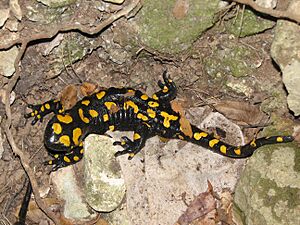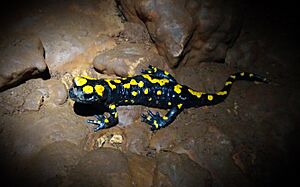Near Eastern fire salamander facts for kids
Quick facts for kids Near Eastern fire salamander |
|
|---|---|
 |
|
| Conservation status | |
| Scientific classification | |
| Genus: |
Salamandra
|
| Species: |
infraimmaculata
|
| Synonyms | |
|
|
The Near Eastern fire salamander (Salamandra infraimmaculata) is a special type of salamander. In Arabic, people call it arouss al-ayn. You can find this amazing creature in countries like Iran, Iraq, Turkey, Syria, Lebanon, and Israel. These salamanders love to live in warm, dry areas with shrubland and forests. They often stay close to rivers and fresh springs. Sadly, their homes are shrinking because of habitat loss, which means they are becoming threatened.
Contents
What Does the Near Eastern Fire Salamander Look Like?
This salamander is mostly black with bright yellow spots on its back. These yellow spots are a warning sign to predators, telling them to stay away! Its skin is smooth and shiny. Usually, it has four big yellow spots on its head.
Different types, called subspecies, have slightly different patterns. For example, one type called S. i. orientalis looks very much like S. i. infraimmaculata. But it has many more yellow dots all over its body. Another type, S. i. semenovi, has a rounder head. It also has rose-shaped spots on its upper body.
The Near Eastern fire salamander can grow quite long, up to 324 mm (12.8 in). The S. i. infraimmaculata type is the largest. Female salamanders are usually bigger than males.
Where Do Near Eastern Fire Salamanders Live?
You can find Near Eastern fire salamanders in Anatolia in Turkey. They also live in parts of northern Iran, northern Iraq, Syria, and Lebanon. In northern Israel, they are found near the ancient city of Tel Dan. They also live in northern and western Galilee and the Mount Carmel area. These salamanders can live in places from 180 to 2,000 metres (590 to 6,560 ft) above sea level.
They live in different kinds of forests, depending on the area. In Iran, they like open cork forests with trees spread out. In Turkey and Lebanon, they prefer damp woods and groves in mountains and hills. They especially like areas near water. During the day, they hide under leaves, roots, or rocks to stay safe. At night, they come out to search for food. You can also find them near springs and temporary pools. These pools form after winter rains. In Israel, they live around pools and slow-moving streams fed by springs.
In spring, male salamanders grow yellowish bumps around their eyes. The bigger these bumps are, the better their chances of finding a female partner. This helps them have more babies.
How Do Near Eastern Fire Salamanders Live?
These salamanders can live a long time! Males can live up to 23 years, and females up to 21 years. Adult salamanders usually live on land. However, they need water for breeding. Females lay their eggs in ponds. Both males and females often return to the same water bodies for breeding.
Adult salamanders are active at night. They spend their days hiding. During the hottest summer months, they might aestivate, which is like a summer sleep. This depends on where they live. Salamanders in higher, colder places hibernate during winter. They are very loyal to their hiding spots and breeding places. It was once thought they stayed in small areas. But now we know they sometimes travel far from their usual homes.
What Do Near Eastern Fire Salamanders Eat?
Adult salamanders live on land and eat many different things. They munch on insects, earthworms, slugs, and snails. They also eat other small creatures without backbones. Sometimes, they even eat young salamanders of other species.
Baby salamanders, called larvae or tadpoles, live in water. They mostly eat tiny crustaceans and mosquito larvae. They also eat tadpoles of frogs and toads. These larvae can be quite aggressive towards each other. They sometimes even eat other salamander larvae, which is called cannibalism. They are more likely to eat tadpoles that are not their brothers or sisters. If fish are in the pond, they will eat many salamander tadpoles. But if there are no fish, the salamander tadpoles are at the top of the food chain. They have a big impact on what other species live in the pool.
Life Cycle and Reproduction
Breeding happens during the colder winter months. The male holds the female in a special hug called a ventral amplexus. He then leaves a small packet of sperm, called a spermatophore, on the ground. He moves his tail so the female can pick it up with her cloaca. She then draws it inside her body. A female might get sperm packets from several different males.
This salamander is ovoviviparous. This means the eggs stay inside the female's body. The babies develop inside her until they are ready to hatch. It can take about a year from when the eggs are fertilized until the live tadpoles are born into pools. The female does not lay all her tadpoles at once. She visits several ponds, choosing ones that do not have many large salamander larvae already. She also looks for ponds with lots of small hiding places for her young tadpoles.
Larvae Development
When the larvae are born, they weigh about 20 g (0.7 oz). They already have two pairs of legs and two sets of outside gills. They use their finned tails to swim and grow very quickly.
Larvae can tell if the water in their pond is getting low. If it is, they quickly change into their land-living form. This change helps them survive before the water dries up. They also develop bigger heads during this change.
Soon, they meet other larvae. If there isn't enough food, they might start eating each other. This might be a way for some of them to survive if their temporary pools are drying up. It might also happen if there are dead tadpoles or if the water quality changes. In these tough situations, cannibalism can help some tadpoles live. Larvae grow to about 5–7 cm (2.0–2.8 in) before they change into adult salamanders. This change, called metamorphosis, takes about two to four months.
Is the Near Eastern Fire Salamander in Danger?
The Near Eastern fire salamander is listed as "Near Threatened" on the IUCN Red List of Threatened Species. This means it could become endangered soon. In some places, there are many of them. But in other areas, they are rare.
In Israel and Lebanon, they are considered threatened. This is because of new roads being built and water being polluted by pesticides. Also, new fish like the mosquitofish (Gambusia affinis) can eat many salamander tadpoles. This greatly reduces how many survive to become adults.
In Turkey, the number of salamanders is going down. Threats include water bodies drying up because too much groundwater is taken. Dams on streams, traffic, and homes being built also break up their living areas. In Israel, it is listed as "Endangered". It is protected by national laws there. In Lebanon, we don't know its exact status. In Syria, it is considered vulnerable because its habitat is being destroyed. Luckily, in both Turkey and Israel, these salamanders live in some national parks. In these parks, they should be safe.
Can You Keep a Near Eastern Fire Salamander as a Pet?
Yes, you can keep this salamander as a pet! People have even had success breeding them in captivity. One female salamander, brought from Lebanon in 1966 as a larva, had 79 babies in 2007. Four years later, she had 102 more babies!




